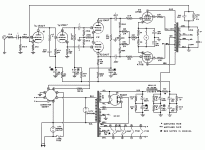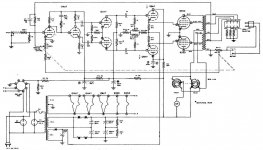A tube amp was given to me. I powered it up and the 4 rectifier tubes lit up, about 5 of the 12AU7 tubes lit up, and the longer slender tube by the choke flickered / stayed constant/flickered. I think I have a stereo integrated amp. Please see my images attached.
I searched in the vintage Hammond catalogue and came up with the following:
2 x Hammond 1626X OT's, 20 W each. "X" means chassis mount
1 x Hammond 710X T 110VA
1 x Hammond 1136X T 78VA
1 x Hammond 159ZC 06H 2000mA choke
The rectifier tubes are RCA 7027A tubes and the slender flickering tube I am not sure, the label reads 0A? .
Think this might be a project to spruce up modernize a bit. Since I am a novice in this hobby, I am looking for comments and recommendations.
Regards,
Myles
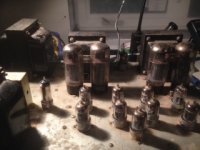
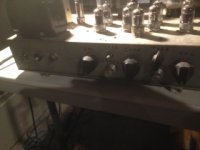
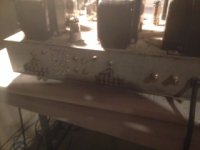
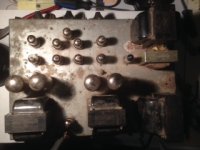
I searched in the vintage Hammond catalogue and came up with the following:
2 x Hammond 1626X OT's, 20 W each. "X" means chassis mount
1 x Hammond 710X T 110VA
1 x Hammond 1136X T 78VA
1 x Hammond 159ZC 06H 2000mA choke
The rectifier tubes are RCA 7027A tubes and the slender flickering tube I am not sure, the label reads 0A? .
Think this might be a project to spruce up modernize a bit. Since I am a novice in this hobby, I am looking for comments and recommendations.
Regards,
Myles




First comment is unplug it and don't repower it until you have a safety device in line to limit current, and a circuit diagram, or better knowledge of what you are looking at and touching.
The OA is a regulator tube, probably a 150v device. The 7027 is not a rectifier, its the power tubes driving the output transformers
Some images larger than a postage stamp would help.
The OA is a regulator tube, probably a 150v device. The 7027 is not a rectifier, its the power tubes driving the output transformers
Some images larger than a postage stamp would help.
Last edited:
Thanks A10,
Only had it powered to see what lit up. All the smaller tubes are the 12AU7 / 12AU7A / 12AU7WA variety. I was trying to minimize the size of the pics, as most folks can max or min the size on their computers. With the transformers on board, you think it is worthy of a rebuild?, or hard to tell unless you see the insides.
On the one pic there is a bass & treble control for each channel and the channel selector. The back photo shows how old this amp may be. Thanks for the help.
Only had it powered to see what lit up. All the smaller tubes are the 12AU7 / 12AU7A / 12AU7WA variety. I was trying to minimize the size of the pics, as most folks can max or min the size on their computers. With the transformers on board, you think it is worthy of a rebuild?, or hard to tell unless you see the insides.
On the one pic there is a bass & treble control for each channel and the channel selector. The back photo shows how old this amp may be. Thanks for the help.
Old, intact, transformers are usually worth a full rebuild.
That collection of 12AU7s suggests Williamson style power section topology, that should resemble whats found in the Heathkit W5M. The 7027, like the KT66, is a member of the 6L6 "clan".
You will have to trace things out and determine whether the amp is self or "fixed" bias.
1626X doesn't mesh with Hammond's product chart. 1620 is a 20 W. part whose 6600 Ω primary is correct for 6L6 family tubes, but it's WAY undersized for a pair of 7027s.
That collection of 12AU7s suggests Williamson style power section topology, that should resemble whats found in the Heathkit W5M. The 7027, like the KT66, is a member of the 6L6 "clan".
You will have to trace things out and determine whether the amp is self or "fixed" bias.
1626X doesn't mesh with Hammond's product chart. 1620 is a 20 W. part whose 6600 Ω primary is correct for 6L6 family tubes, but it's WAY undersized for a pair of 7027s.
Attachments
0A2 is the flickering one. It is a gas voltage regulator tube that should regulate at 150V at 30mA. It's basically the old fashioned equivalent to a zener diode.
Thank you all for your input so far. For what its worth, I looked up all the large iron in the Vintage Hammond catalogue. Please see below.
Hammond Catalogue - 1974
1600 SERIES - 10 Watt to 75 Watt
• Designed for Hi-Fi, Stereo or P.A. system applications (Tube circuits).
• Sturdy, convenient, 4 hole above chassis
• Screen taps on 1 620 (21 % of pri. turns) and 1626 (41 % of pri. turns); for ultra-linear
operation if required.
• Frequency response 50 to 15 kHz (-1 dB ref 1 000 Hz minimum) Type 1626 is from 30 to 30
kHz
Cat. Audio Primary Max. DC mA Secondary Core
No. Watts Impedance Per Side Impedance Size
1626 20 6600 ct 80 4/16 1-1/4 x l- l/4
FILAMENT AND RECTIFIER TRANSFORMERS Multiple Secondary
Cat. Secondary Sec. rms. Core
No. Volts Amps Ins, Test
1136X 5.0 ct 3.0 2500 1.25 x 1.75
PLATE TRANSFORMERS - Primary 115 Volts, so/60 Hz
Cat. Secondary O.C. Vohs D.C. mA Core
No. A.C. Volts Choke Input CCS ICAS
710 375-0-375 300 300 450 1.5 x 1.25
HIGH CURRENT BRACKET MOUNTED CHOKES
Cat. lnduc. Current Resist. Max.Op.
No. Henry mA DC Ohms Volts DC
159 zc 60 mH 2000 0.3 500
6A3s: I am sure it is a home made amp. There is brown burn marks on the backside (closest to the 1626's) of each 7027, which would indicate hotness.
If I was to rebuild this amp, would a good starting point be testing the transformers and other iron to see if good, or was powering up a good enough indication?
Anyone have a link for an outline on re-building (ie: procedures, steps, etc)
Two questions I have: The secondary impedance for the 1626 transformers is quoted as 4/16. Does this mean it is also good for 8ohms. Other transformers are listed as 4-8-16 ohms, hence the question.
2) What would be a good power tube to use and is there a modern regulator tube available.
Thanks for your comments, I can use all the help I can get.
MM
Hammond Catalogue - 1974
1600 SERIES - 10 Watt to 75 Watt
• Designed for Hi-Fi, Stereo or P.A. system applications (Tube circuits).
• Sturdy, convenient, 4 hole above chassis
• Screen taps on 1 620 (21 % of pri. turns) and 1626 (41 % of pri. turns); for ultra-linear
operation if required.
• Frequency response 50 to 15 kHz (-1 dB ref 1 000 Hz minimum) Type 1626 is from 30 to 30
kHz
Cat. Audio Primary Max. DC mA Secondary Core
No. Watts Impedance Per Side Impedance Size
1626 20 6600 ct 80 4/16 1-1/4 x l- l/4
FILAMENT AND RECTIFIER TRANSFORMERS Multiple Secondary
Cat. Secondary Sec. rms. Core
No. Volts Amps Ins, Test
1136X 5.0 ct 3.0 2500 1.25 x 1.75
PLATE TRANSFORMERS - Primary 115 Volts, so/60 Hz
Cat. Secondary O.C. Vohs D.C. mA Core
No. A.C. Volts Choke Input CCS ICAS
710 375-0-375 300 300 450 1.5 x 1.25
HIGH CURRENT BRACKET MOUNTED CHOKES
Cat. lnduc. Current Resist. Max.Op.
No. Henry mA DC Ohms Volts DC
159 zc 60 mH 2000 0.3 500
6A3s: I am sure it is a home made amp. There is brown burn marks on the backside (closest to the 1626's) of each 7027, which would indicate hotness.
If I was to rebuild this amp, would a good starting point be testing the transformers and other iron to see if good, or was powering up a good enough indication?
Anyone have a link for an outline on re-building (ie: procedures, steps, etc)
Two questions I have: The secondary impedance for the 1626 transformers is quoted as 4/16. Does this mean it is also good for 8ohms. Other transformers are listed as 4-8-16 ohms, hence the question.
2) What would be a good power tube to use and is there a modern regulator tube available.
Thanks for your comments, I can use all the help I can get.
MM
What would be a good power tube to use and is there a modern regulator tube available.
Old Stock (OS) 0A2s are easy enough to source, should using the type be desirable.
Hammond's chart suggests 6V6s and 6AQ5s (which are very similar), along with 6L6s. The original 6L6 has a 19 W. plate and pair of those operating in either ultra-linear (UL) or full pentode mode will overload the "iron". However, triode wiring reduces power O/P and could work out well. It would not be surprising to find those 7027s (6L6s "on steroids") are triode wired. FYI, Williamson's seminal amp used triode wired KT66s. 😉
Two questions I have: The secondary impedance for the 1626 transformers is quoted as 4/16. Does this mean it is also good for 8ohms. Other transformers are listed as 4-8-16 ohms, hence the question.
The wiring of Hammond 16nn series secondaries is somewhat tricky, but several speaker impedances are supported. Look here.
Thanks Eli for the comments. So looking at the link for 6L6 triode wired, the output would be 1.4 watts if I am reading correctly, Correct?
Is that per tube or based on 2 tubes?
If I used triode tubes, could you estimate the usable watts generated per channel?
MM
Is that per tube or based on 2 tubes?
If I used triode tubes, could you estimate the usable watts generated per channel?
MM
Power O/P is primarily governed by the plate dissipation limit and class of operation. The maximum theoretical efficiency for Class "A" devices (tubes or SS) is 50%, while the Class "B" number is 78.5%. The commonly used Class "AB" (obviously) is somewhere in between. In the real world, Class "A" triodes exhibit an efficiency of roughly 20%, while pentodes and beam power tetrodes operating "natively" yield about 40%, for Class "A".
An interesting, but costly, option for recycling the 20 W./6600 Ω primary (end to end) O/P transformers is 300B directly heated triodes (DHTs). A push/pull (PP) pair of 300Bs running in Class "A" would produce approx. 16 W. The fit is very good and a global NFB loop would not be employed, which dodges the issue of magnetic headroom for core saturation prevention.
15 WPC is a realistic goal from a PP pair of "12" W. tubes, like 6V6s or EL84s. However, 8000 Ω primary O/P transformers are the "norm", for those types.
Back to the 6L6 "clan" for reasons of economy and primary impedance fit. A popular variant is the 5881 equivalent Russian 6Π3C-E (6p3s-e). When triode wired, a PP 6Π3C-E pair would (IMO) be a very reasonable alternative to expensive 300B DHTs, for 16 or so WPC. Remember, topologies (like Williamson) that employ a GNFB loop are excluded, due to insufficient magnetic headroom.
BTW, get the 7027s tested. If they are strong, some $ towards funding the project can be generated. Sadly, the 7027s are a poor fit (power O/P wise) for the Hammond O/P "iron" in your possession. 40 W. from a PP pair of 7027s is pretty darned easy.
An interesting, but costly, option for recycling the 20 W./6600 Ω primary (end to end) O/P transformers is 300B directly heated triodes (DHTs). A push/pull (PP) pair of 300Bs running in Class "A" would produce approx. 16 W. The fit is very good and a global NFB loop would not be employed, which dodges the issue of magnetic headroom for core saturation prevention.
15 WPC is a realistic goal from a PP pair of "12" W. tubes, like 6V6s or EL84s. However, 8000 Ω primary O/P transformers are the "norm", for those types.
Back to the 6L6 "clan" for reasons of economy and primary impedance fit. A popular variant is the 5881 equivalent Russian 6Π3C-E (6p3s-e). When triode wired, a PP 6Π3C-E pair would (IMO) be a very reasonable alternative to expensive 300B DHTs, for 16 or so WPC. Remember, topologies (like Williamson) that employ a GNFB loop are excluded, due to insufficient magnetic headroom.
BTW, get the 7027s tested. If they are strong, some $ towards funding the project can be generated. Sadly, the 7027s are a poor fit (power O/P wise) for the Hammond O/P "iron" in your possession. 40 W. from a PP pair of 7027s is pretty darned easy.
+1 for 6P3S in triode mode... My first builds used that config and they are still relatively cheap (I paid 4$CAD for mine, they are more like 10$CAD now). I actually prefer the 6P3s to the more expensive E version.
6P3S / 6L6GT tube → POWER / OUTPUT tubes → Tubes-Store.com
6P3S / 6L6GT tube → POWER / OUTPUT tubes → Tubes-Store.com
Last edited:
Thanks for the vaiuable info. I have all the parts for building a set of EL34 (bandol83 group buy) except the transformers and will be building in the future.
Question: If I build a 6l6 or6P3S variant, will it sound similar to the EL34 or would be a good amp for the stable also? Maybe spending $$ on 300B for a different sound is not so bad.
kodabmx: Would you happen to know any persons that could test the 4 x 7027's and 20 x 12au7 cheaply.? I may start a thread looking for testers in BC or Alberta also.
MM
Question: If I build a 6l6 or6P3S variant, will it sound similar to the EL34 or would be a good amp for the stable also? Maybe spending $$ on 300B for a different sound is not so bad.
kodabmx: Would you happen to know any persons that could test the 4 x 7027's and 20 x 12au7 cheaply.? I may start a thread looking for testers in BC or Alberta also.
MM
The easiest would be to build a test circuit for the 12AU7 and measure them like that. You're in BC? Sphere Research might have a tester...
The EL34 will put out more power as a triode. If you already have everything but the XFMRs I'd just build for the EL34.
Sphere Research Corporation - Used Electronic Test Equipment, Spare Parts, Slide Rules and more...
The EL34 will put out more power as a triode. If you already have everything but the XFMRs I'd just build for the EL34.
Sphere Research Corporation - Used Electronic Test Equipment, Spare Parts, Slide Rules and more...
So you don't think that a 300B would be a worthwhile endeavor with what I have. I would buy new tubes and use the existing Xmrs & other iron. Plan for new chassis.
MM
MM
Using 300Bs involves a substantial cash outlay and Hammond "iron" is not top shelf. FWIW, straight shooting Jim McShane charges 209.50 USD for a hand matched pair of 300Bs. The difference in cost between those and 6Π3C-E stock is substantial. Frankly, the Russian tube is more than good enough for use with Hammond "iron".
A new, well thought out, chassis is (IMO) an excellent idea.
A new, well thought out, chassis is (IMO) an excellent idea.
Thanks for the help Eli. More realistic for me to rebuild the amp within my means. So going the 6L6 family/6p3s/6n3C or the E variety seems reasonable.
If I was searching for schematics, would I be looking for SE schematics?
MM
If I was searching for schematics, would I be looking for SE schematics?
MM
If I was searching for schematics, would I be looking for SE schematics?
No, you want push/pull (PP) schematics. Something built with 300Bs could be a starting point. I state that as no loop NFB is something DHT setups frequently employ. The "classic" Williamson and Mullard topologies employ a global NFB loop and this project will not.
Let's look closely at the 5881 datasheet. The section describing a PP triode wired pair operating in Class "AB1" reveals a major stumbling block.
 Notice (sic) 4.4% THD and that will be objectionable odd order products. Push/Pull pairs cancel the euphonic even order products. Williamson used plenty of GNFB for good reason. Back to the drawing board. 🙁
Notice (sic) 4.4% THD and that will be objectionable odd order products. Push/Pull pairs cancel the euphonic even order products. Williamson used plenty of GNFB for good reason. Back to the drawing board. 🙁I'm beginning to think PP EL84s running at comparatively low plate voltage and comparatively high plate current will be the practical solution. Bandersnatch's "exolinear" topology could solve the GNFB conundrum. Let me see if I can draw his attention to this thread.
While I'm "at it", wade through the EXTENSIVE "Baby Huey" thread. That short loop concept avoids the magnetic headroom problem too.
Thanks Eli. I have waded thru both the BH El34 & the Gingertube EL84 threads. Not to long ago I had multiple pcbs on hand for both the BH EL34 & the EL84. I sold all of them except for one 2 of Marc's original EL34 pcbs. I have more or less got rid of a lot of pcbs and other components to narrow my building activities. I will search for PP schematics also, keeping in mind V and I parameters as you stated above and revisit the EL 84 threads also. I will PM gingertube and ask him his opinion.
MM
MM
Eli,
Referring to the 5881 datasheet, What are the specs of the Class AB2 PP Amp that makes it unsuitable for my existing iron (trying to learn what ro be looking for).
MM
Referring to the 5881 datasheet, What are the specs of the Class AB2 PP Amp that makes it unsuitable for my existing iron (trying to learn what ro be looking for).
MM
Eli,
Referring to the 5881 datasheet, What are the specs of the Class AB2 PP Amp that makes it unsuitable for my existing iron (trying to learn what ro be looking for).
MM
Excessive power O/P; 31 W. will overwhelm the "iron" in your possession.
Excessive odd order distortion is produced. PP cancels even order products and GNFB can't be used.
When you see Class "x2", the 2 means a (sic) positive control grid current regime. That, in turn, requires either interstage coupling transformers or voltage followers to provide the necessary low impedance power. You can see that sort of thing in the attached Heathkit W6M schematic. It's not straightforward.
Attachments
- Home
- Amplifiers
- Tubes / Valves
- Tube amp identification
